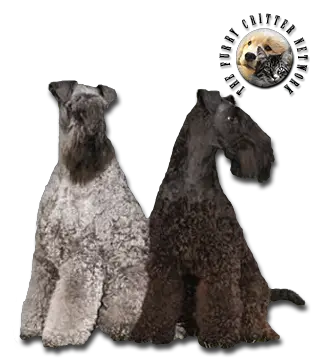Breed Standard
Head: Strong, with abundant hair. Slight stop. Powerful, muscular, (fearsome) jaws. Gums and palate of dark color.
Ears: Small, thin leather, carried forward or falling forward against the sides of the head.
Eyes: Medium size. Dark hazelnut or dark color.
Body: Compact and muscular. Moderately long neck. Broad, high forechest. Chest well let down. Ribs well sprung. Straight back. Short loin
Tail: Thin. Set on high and carried gaily erect.
Hair: Soft, dense, and wavy.
Coat: Any shade of blue, with or without black on the extremities. Black or fawn permissible up to the age of eighteen months. The Kerry is born black and the coat gradually lightens to blue around fifteen to eighteen months of age.
Size: Dog: 45.5 to 49.5 cm (18-19.5 in).Bitch: 44.5 to 48 cm (17.5-19 in).
Weight: Dog: 15 to 18 kg (33-40 lb).Bitch: proportionally lighter.
History
Many years ago in the county of Kerry in southwestern Ireland, the Blue Kerry Terrier hunted badger, fox, and otter. His ancestors probably include the Bedlington Terrier, the Bull Terrier, the Irish Terrier, and the Wolfhound. The Blue Kerry Terrier is the largest of the Irish terriers. He was first exhibited at a dog show in 1887. The breed's standard was fixed by the Irish registry in 1920, and today the Kerry Blue Terrier has become a national symbol in Ireland. In 1923, the breed was recognized by The Kennel Club.
Behavior
This hardy, fiery dog is stubborn but relatively calm. He is very friendly with his owners and gentle with children. Dominant and cantankerous, he is aggressive toward other dogs and pets. An excellent guard dog, he is courageous and will bite. This strong swimmer is used to attack otters in deep waters. As a ratter, he has no equal. Training should be firm, but not harsh or unkind.
The Kerry Blue Terrier can adapt to life indoors but he requires plenty of daily exercise. Regular brushing is required. It is soft and wavy with no undercoat. The texture is similar to that of fine human hair and like human hair does not shed but continues to grow throughout the year. This means the Kerry Blue requires very regular grooming (at least once per week) and clipping an average of every 6 weeks.
Function
Hunting Dog (rabbit, vermin, etc.), Guard Dog, Utility Dog, Police Dog, Pet.
Health
Kerries are fairly healthy, however there are some genetic disorders that are prevalent in the breed. They are prone to eye problems such as Keratoconjunctivitis sicca (dry eyes), cataracts, and entropion. They sometimes get cysts or tumorous growths in their skin, but these are rarely malignant. Hip dysplasia, hypothyroidism, cryptorchidism have also been reported. Progressive neuronal abiotrophy (PNA) is also seen but rare in the population. This condition is also referred to as Cerebellar cortical abiotrophy (CCA) or Cerebellar Abiotrophy (CA). Another skin-related health issue is spiculosis. This is a skin disorder that produces abnormally thick hairs that are also called thorns, spikes or bristles.






